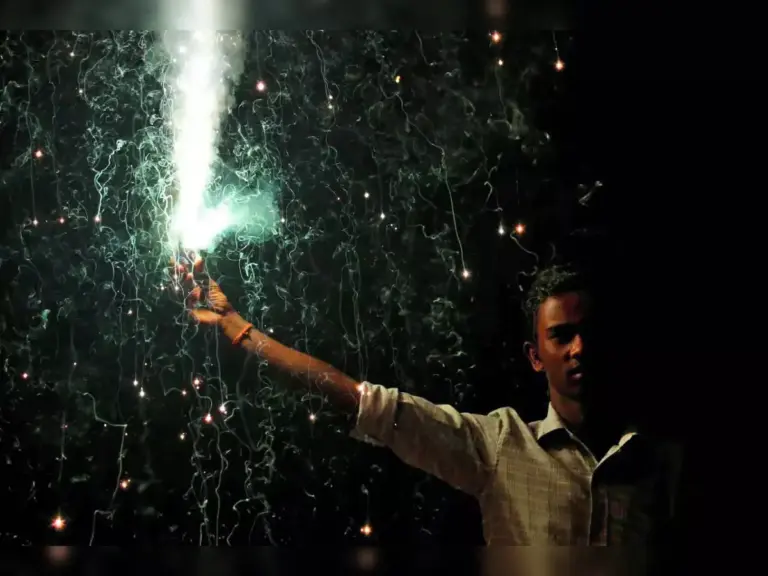Diwali has come and gone. What is lingering is the toxic cloak of haze covering Delhi and NCR. Choreographed shock and outrage have followed as sure as smoke follows fire. On Tuesday, Delhi’s air quality was in the ‘very poor’ category. Parts of India’s capital city found themselves breathing toxic air that falls in the ‘severe’ category. By Tuesday midnight, Delhi’s average hourly PM2.5 levels touched 675 micrograms/cu m, the highest since 2021.
Roll back a few weeks. On Oct 6, Delhi CM Rekha Gupta announced that ‘her government’ would approach the Supreme Court to seek permission to allow bursting of green firecrackers on Diwali in NCR, adding that ‘her government’ decided to approach the court ‘in view of crores of people who celebrate the festival in the city’. Ultimately, a petition from fireworks manufacturers’ association and GoI submitting an enforcement plan made the Supreme Court lift the ban on the sale and bursting of green firecrackers on Oct 15.
The court stated that this was a temporary measure to find a ‘balanced approach’ between public sentiment and environmental protection. It also laid down strict (sic) regulations, including limited timings for bursting (6-7 a.m. and 8-10 p.m. on the day before and day of Diwali), designated sale points, and a QR-code traceability system for manufacturers and vendors. In addition, Commission for Air Quality Management in NCR and Adjoining Areas (CAQM) had invoked Graded Response Action Plan (Grap), Stage 2, before Diwali day.
We all know what happened on the ground since – and despite – the Oct 15 Supreme Court order. Most of us are breathing it, coughing it away with ‘We are like this only’.
CSIR-Neeri (National Environmental Engineering Research Institute)-developed ‘green crackers’ reportedly produce 30% less pollution than conventional firecrackers, as they contain less amounts of chemicals like barium and aluminium, and include additives that suppress dust and smoke. Even if one considers that everyone bursting crackers beyond the regulated 3 hrs on Oct 19 and 20 (never mind on Dhanteras, or well after Diwali) used green crackers, 30% less pollution is only 30% less toxic fumes. And, clearly, it wasn’t just ‘green’ crackers being burst over the last few days.
As always, Delhi’s air will, over time, shift from ‘severe’ to ‘very poor’ to ‘poor’. When AQI levels reach 101-200 (‘moderate’), quiet celebrations will again break out and ‘Diwali dhamaka’ will seem ‘worth’ our hazardous habits.
Bursting fireworks regardless of the harm they bring to the health and well-being of citizens – especially the old, infants and animals – is always justified as cultural practice. In buying banned crackers and bursting them beyond allotted hours, it is the citizenry of Delhi-NCR who are primary actors, with enforcers essentially goading them on to do what they deem non-negotiable.
According to the 2025 Energy Policy Institute, University of Chicago (EPIC), Air Quality Life Index (AQLI) report, Delhi-NCR’s residents could live 8.2 yrs longer if the region’s pollution levels were within WHO standards. In an assessment conducted by CPCB in late October 2024, only 21 of 255 cities/towns across India recorded an AQI of less than 50 (‘good’). This presents a gloomy scenario not just for Delhi-NCR but the country as a whole that is supposedly planning to become ‘viksit’ in 22 years.
Average Indians tend to lose over 5 yrs of lifespan due to air pollution. Loss to economy in terms of medical costs and loss of labour can be staggering. And, yet, flying in the face of these facts, our ‘jan adhikaar’ overwhelms any other rational reasoning.
Agencies step up usual action and controls. Mechanical sweeping, water sprinkling and dust control measures swing into action at pollution hotspots. Green public transport is being augmented, traffic movements synchronised, polluting vehicles restricted, parking fees hiked for vehicles, and power generating sets regulated. These are good measures. But they are hardly sufficient if no one really cares about civic well-being that includes their own and of their loved ones.
The issue of pollution, centred around policy and regulatory failures, needs to be part of our political discourse. But it isn’t. The citizen charter under Grap looks like a tall wish list to us, while in more developed, self-conscious countries, such measures – like avoidance of open burning solid waste and biomass, littering and garbage disposal in the open, and dust-generating construction activities – are standard operating (non-)practices. Violations are seen as anomalies, not de rigueur.
We, as citizens, must stop tolerating seasonal smoke and haze, and the suffering that accompanies them borne out of our own atavistic actions. The onus is on citizens, households and RWAs to stop breaking norms to celebrate festivals that should bring joy to all.
The quality of a society is the quality of life its members choose. Gazing at the rising and falling curve of AQI levels on smartphones and engaging in seasonal blame games may be addictive. But it makes everyone – including those garrisoned in their homes every Diwali night, or those who flee the city every year during the ‘festival of blights’ – merely get what they wish for: Third World life.
(Disclaimer: The opinions expressed in this column are that of the writer. The facts and opinions expressed here do not reflect the views of www.economictimes.com.)
Images are for reference only.Images and contents gathered automatic from google or 3rd party sources.All rights on the images and contents are with their legal original owners.
